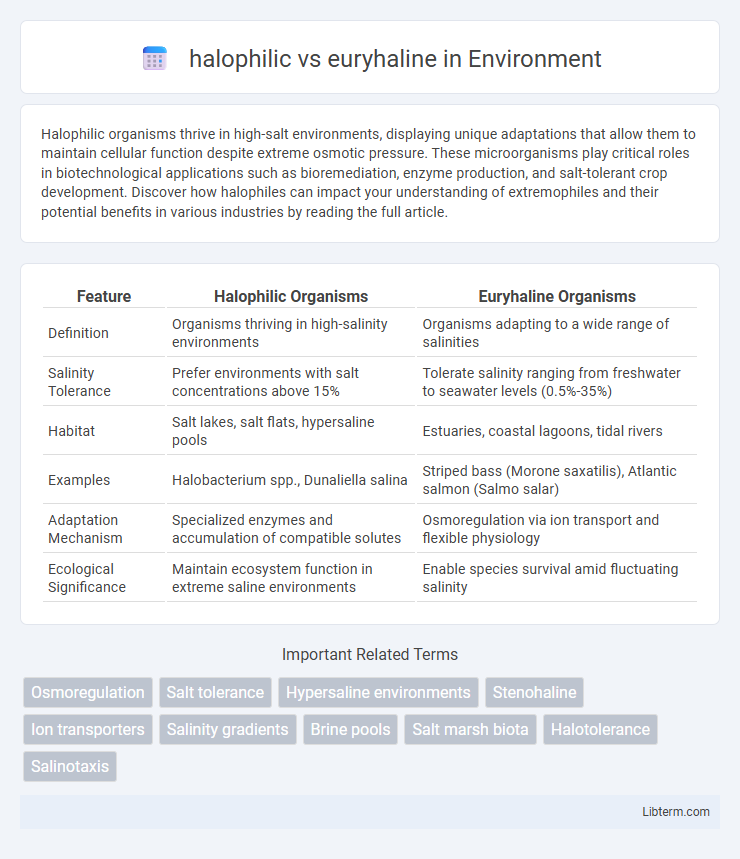Halophilic organisms thrive in high-salt environments, displaying unique adaptations that allow them to maintain cellular function despite extreme osmotic pressure. These microorganisms play critical roles in biotechnological applications such as bioremediation, enzyme production, and salt-tolerant crop development. Discover how halophiles can impact your understanding of extremophiles and their potential benefits in various industries by reading the full article.
Table of Comparison
| Feature | Halophilic Organisms | Euryhaline Organisms |
|---|---|---|
| Definition | Organisms thriving in high-salinity environments | Organisms adapting to a wide range of salinities |
| Salinity Tolerance | Prefer environments with salt concentrations above 15% | Tolerate salinity ranging from freshwater to seawater levels (0.5%-35%) |
| Habitat | Salt lakes, salt flats, hypersaline pools | Estuaries, coastal lagoons, tidal rivers |
| Examples | Halobacterium spp., Dunaliella salina | Striped bass (Morone saxatilis), Atlantic salmon (Salmo salar) |
| Adaptation Mechanism | Specialized enzymes and accumulation of compatible solutes | Osmoregulation via ion transport and flexible physiology |
| Ecological Significance | Maintain ecosystem function in extreme saline environments | Enable species survival amid fluctuating salinity |
Introduction to Salinity Adaptations
Halophilic organisms thrive in environments with extremely high salt concentrations, often exceeding 15% salinity, by accumulating compatible solutes and maintaining intracellular ionic balance. Euryhaline species demonstrate remarkable adaptability, tolerating a wide range of salinities from freshwater to marine conditions through dynamic osmoregulation and ion transport mechanisms. Understanding these salinity adaptations is crucial for studying microbial ecology, aquaculture, and evolutionary biology in fluctuating saline habitats.
Defining Halophilic Organisms
Halophilic organisms thrive in high-salinity environments, typically requiring salt concentrations above 3% to maintain cellular functions and osmotic balance. These extremophiles employ specialized adaptations such as compatible solutes, salt-in cytoplasm strategies, and unique enzymes to survive in hypersaline habitats like salt lakes and salt mines. In contrast, euryhaline organisms tolerate a wide range of salinities but do not necessarily require high salt concentrations for growth.
Understanding Euryhaline Species
Euryhaline species possess remarkable osmoregulatory mechanisms that enable them to tolerate a wide range of salinities, from freshwater to marine environments, unlike halophilic organisms that thrive exclusively in high-salinity habitats. Key examples include species such as the Atlantic salmon (Salmo salar) and the European eel (Anguilla anguilla), which migrate between freshwater and seawater during their life cycles. Understanding euryhaline adaptations provides critical insights into evolutionary biology, aquaculture practices, and the ecological resilience of aquatic species facing fluctuating salinity levels.
Habitats: Salt Concentration Extremes
Halophilic organisms thrive in hypersaline habitats with salt concentrations often exceeding 20%, such as salt lakes and salt flats, where few other life forms can survive. Euryhaline species inhabit environments with widely varying salinity levels, ranging from freshwater to marine conditions, including estuaries and tidal zones. These adaptations enable halophiles to specialize in extreme salt concentrations while euryhaline organisms exhibit remarkable osmoregulatory flexibility across fluctuating salinities.
Physiological Mechanisms of Salt Tolerance
Halophilic organisms maintain cellular function in high-salt environments by accumulating compatible solutes like glycine betaine and synthesizing salt-tolerant enzymes to prevent denaturation. Euryhaline species regulate intracellular ion concentration through active transport systems, such as Na+/K+ ATPases and chloride channels, enabling adaptation to varying salinity levels. Both strategies involve osmotic balance and membrane stability adjustments crucial for survival under osmotic stress.
Genetic Adaptations in Halophiles and Euryhalines
Halophiles exhibit genetic adaptations such as specialized ion transport systems and osmoprotectant synthesis genes that enable survival in hypersaline environments. Euryhaline organisms display genetic plasticity with regulatory genes that facilitate rapid osmotic adjustment across varying salinities. Both groups possess unique gene clusters for membrane protein modifications and compatible solute metabolism critical for halotolerance.
Ecological Roles and Distribution
Halophilic organisms thrive in extremely saline environments such as salt lakes and salt flats, playing a crucial role in nutrient cycling and supporting specialized microbial communities. Euryhaline species adapt to a wide range of salinities, commonly inhabiting estuaries and coastal waters, where they maintain ecosystem stability by facilitating energy transfer across varying habitats. The distribution of halophiles is limited to high-salinity niches, while euryhalines are widely dispersed across freshwater, brackish, and marine environments.
Industrial and Biotechnological Applications
Halophilic microorganisms thrive in high-salt environments and produce enzymes, compatible solutes, and biopolymers valuable for industrial processes such as bioremediation, biofuel production, and pharmaceuticals. Euryhaline organisms can survive across wide salinity ranges, making them ideal for biotechnological applications in variable-salinity wastewater treatment and aquaculture systems. Exploiting halophilic and euryhaline species optimizes production efficiency and sustainability in enzyme manufacturing, salt-tolerant bioactives, and environmental biotechnology.
Halophilic vs Euryhaline: Key Differences
Halophilic organisms thrive in high-salinity environments, often exceeding 15% salt concentration, whereas euryhaline species can tolerate a wide range of salinity from freshwater to marine conditions. Halophiles possess specialized cellular mechanisms to prevent dehydration and maintain osmotic balance in hypersaline habitats, while euryhalines exhibit adaptive regulation of ion transport and osmoregulatory processes to survive fluctuating salinity. The key difference lies in halophiles' specialization for extreme salinity versus euryhalines' broad salinity tolerance, impacting their ecological niches and physiological adaptations.
Future Research and Environmental Implications
Future research on halophilic and euryhaline organisms is pivotal for understanding adaptation mechanisms to extreme salinities and their potential biotechnological applications in saline agriculture and bioremediation. Environmental implications include their role in maintaining ecosystem balance in salt-affected habitats and mitigating the impact of increasing soil salinization due to climate change and human activities. Exploring genetic and metabolic pathways in these organisms can enhance strategies for sustainability and resilience in saline environments.
halophilic Infographic

 libterm.com
libterm.com